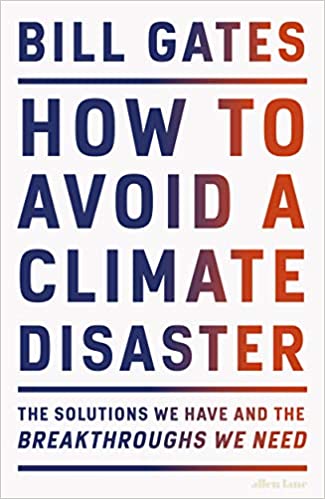A year or so ago I read The Uninhabitable Earth by David Wallace-Wells, which laid out in often horrific details, the kinds of things that would happen to the planet if we didn’t change our ways.
Bill Gates goes for the much more practical, “So what can we do about it now?” approach. This book is basically his plan to cut our carbon emissions from 51 billion tonnes to zero by 2050. That’s it in a nutshell. If we don’t then, like a bath, with even just a slow dripping tap, we’ll end up overflowing and facing some of the consequences that Wallace-Wells laid out in his earlier work.
To do this, in this enormously readable book, Gates takes us through where the emissions come from, and examines ways to work through each of those sectors, which he breaks down into making things, plugging in, growing things, getting around and keeping warm and cool.
He tackles each in turn, although he notes that we spend a lot of time thinking about “getting around” – aka transport – which accounts for 16% of net emissions, but not so much on making steel and concrete. The food industry also gets a good look-in.
Gates is putting his money where his mouth is. Throughout the book he talks about the various companies he’s invested in. This could sound a bit, “Aren’t I clever?” but it doesn’t. He’s just being practical. It comes from the work he and his wife Melinda have carried out through their Gates Foundation in doing very practical things like fighting malaria. So he’s constantly referring to people he’s met, and businesses he’s keenly following.
And throughout, he is very pragmatic. Only a few of us are willing – or even able – to pay a “Green Premium” for some of life’s essentials. He readily acknowledges that the lower the income you are in, the bigger a proportion of your overall costs something like transport will be. So paying even a small premium is simply not affordable. He’s also very aware that the big growth in greenhouse gases is likely to come from developing parts of the world where billions are coming to expect the same kinds of middle-class lifestyles that Americans and Europeans have experienced.
So, what are the solutions? Well, this isn’t really a list of things that you or I can do directly – assuming neither of us is a world leader. There are some of those things, but this is more about policy as well as corporate and governmental support and investment. When we buy the cheapest concrete or steel, there is no carbon-cost attached to it. There’s no incentive to use the greener materials.
And where there are financial incentives, they don’t necessarily help. The energy industry is rife with them, but they protect the enormously cheap fossil fuel industry. On the other hand, laws might make it ridiculously hard to build things like windfarms (a particular problem, seemingly, in the US).
There are things which make you raise your eyebrows a bit. Gates doesn’t believe that just planting lots of trees will fix things. He’s got nothing against trees but I think sees them as a too simplistic solution that will require ongoing care to payback their investment over centuries. He is a big proponent of nuclear fuel, pointing out that while wind and solar energy are fantastic, they don’t provide consistent power. And even though at heart, Gates is a technologist through and through, he doesn’t see battery technology meaningfully moving on, which causes difficulties if you need to store vast amounts of power to even out supply on windless or cloudy days.
Some will look at Gates, flying around in his private jet and wonder if he really practices what he preaches? He acknowledges his own shortcomings, but I think this book shows that he is indeed putting his money where his mouth is.
Getting to net zero will not be easy, as he repeats throughout, but it’s achievable and he’s laid out a plan to get us there.
How to Avoid a Climate Disaster is out now.

